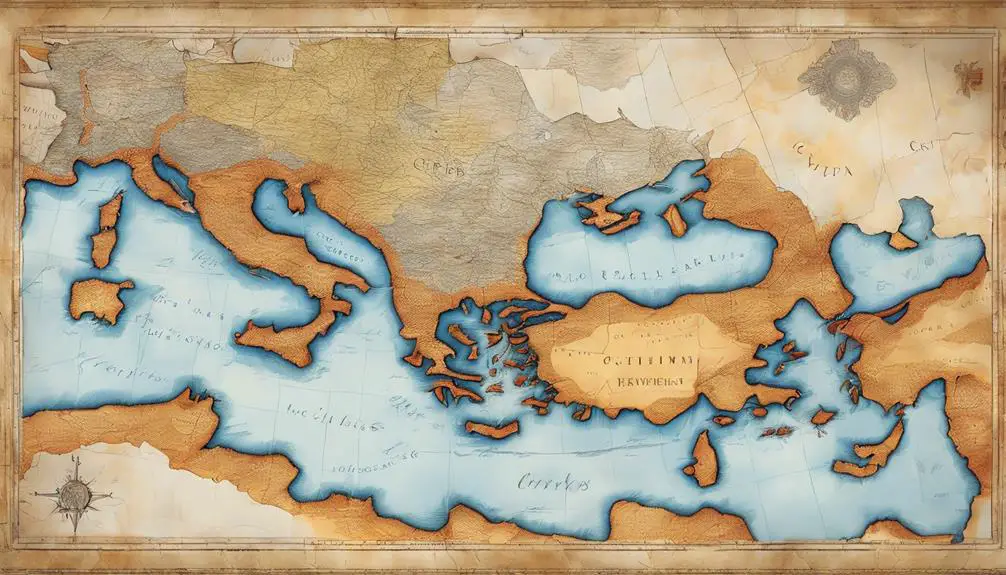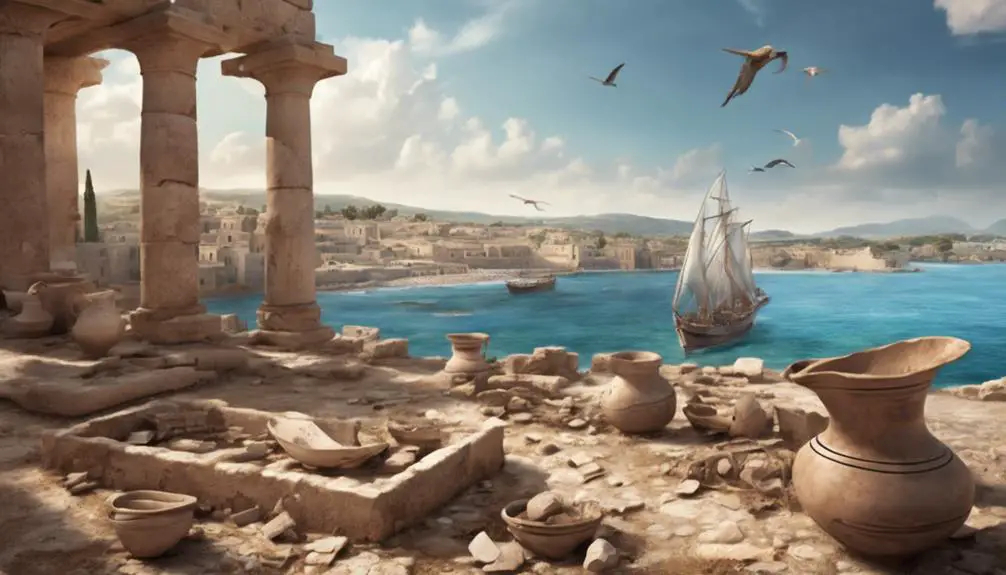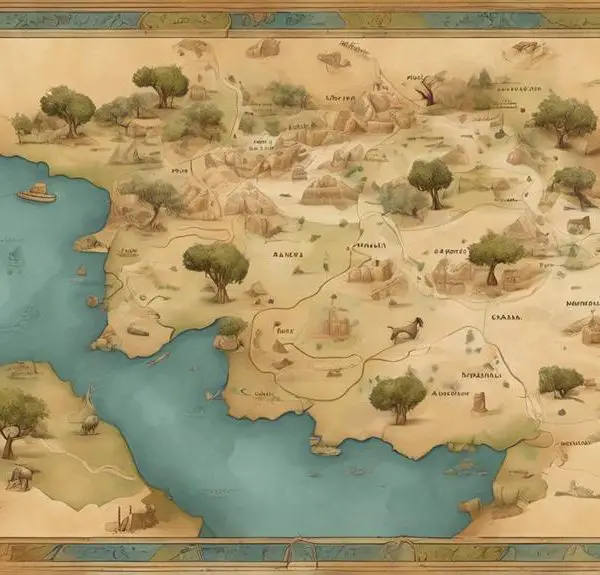Yielding ancient mysteries, Chittim's biblical significance intertwines prophecy and history, inviting a deeper exploration.
Chittim in the Bible
In the tapestry of biblical history, Chittim stands as a thread interwoven with mystery and prophecy. You've likely come across its mention in the scriptures, but have you paused to consider its deeper significance?
Situated at the crossroads of ancient civilizations, Chittim's identity and location offer a fascinating glimpse into the past. Its role in prophecy and symbolism, coupled with archaeological insights, beckon for a closer examination.
Unraveling the story of Chittim not only sheds light on historical narratives but also invites you to explore its impact on contemporary interpretations of biblical prophecy. Why does Chittim hold such an intriguing place in scripture? Let's uncover this together.
Key Takeaways
- Chittim is referenced in biblical prophecy, symbolizing divine judgment and human destiny.
- The location of Chittim, associated with areas like Cyprus, plays a role in ancient Mediterranean geopolitics.
- Archaeological findings in Chittim support its biblical mentions and highlight its role in ancient trade networks.
- Chittim's cultural and economic prosperity reflects its significance in biblical narratives and ancient history.
Biblical Mentions of Chittim

In the Bible, Chittim is referenced in several instances, denoting a location that plays a significant role in prophetic and historical contexts. This term, while seemingly straightforward, encapsulates a rich tapestry of narratives that span both the tangible and the allegorical, offering a window into the complexities of ancient geopolitical landscapes.
The lineage of Chittim's descendants, as outlined in the scriptures, underscores the importance of this group within the broader biblical narrative. These descendants aren't merely footnotes in history; rather, they're integral to understanding the shifting dynamics of power, culture, and influence in the ancient world. Their mention provides insights into the familial and tribal connections that shaped the region's social and political fabric.
Naval battles, a recurring theme in the context of Chittim, further illuminate the strategic significance of this location. The Bible's depiction of these confrontations not only highlights the martial prowess of Chittim's inhabitants but also reflects the broader geopolitical tensions of the era. These maritime conflicts weren't isolated incidents but were symptomatic of larger struggles for control, dominance, and survival in a turbulent historical period.
Through a scholarly lens, one appreciates the multifaceted role Chittim plays in biblical narratives. It's a symbol of both physical place and metaphorical space, where historical events and prophetic visions intertwine. The references to Chittim's descendants and naval battles enrich our understanding of the ancient world's complexity, inviting a deeper exploration of the interplay between history, prophecy, and the enduring legacy of biblical texts.
Identifying Chittim's Location

Having explored the rich narratives and historical significance of Chittim, let's now focus on pinpointing its geographical location within the ancient world. Modern interpretations wrestle with geographic discrepancies, often leading to varied conclusions. Scholars have long debated over the precise location of Chittim, a task complicated by the evolving names and borders of ancient regions.
The consensus, supported by archaeological evidence and historical texts, suggests that Chittim refers to areas in the eastern Mediterranean, primarily linked to Cyprus. This island, rich in copper and strategic maritime routes, fits well into the descriptions found in ancient texts. Yet, the term 'Chittim' has also been associated with coastal regions of modern-day Turkey and even parts of Greece. These areas, like Cyprus, were integral to maritime trade and cultural exchanges in the ancient world.
Modern interpretations must navigate these geographic discrepancies, considering the fluidity of ancient geopolitical landscapes. The challenge lies in reconciling biblical references with historical and archaeological records. For instance, the mention of Chittim in the context of invasions or trade relations might imply different locations at different times, reflecting the shifting dynamics of ancient powers.
This analytical journey into identifying Chittim's location underscores the complexity of ancient history. It's a reminder that geographical terms in ancient texts often encompass broader, more fluid regions than modern maps suggest. As you delve deeper into the history of Chittim, keep in mind the nuanced interpretations required to navigate these ancient landscapes.
Historical Context and Significance

Understanding the historical context and significance of Chittim sheds light on its pivotal role in the geopolitical and economic landscapes of the ancient Mediterranean. Chittim's rulers played a crucial part in shaping the region's dynamics, engaging in diplomacy, trade, and sometimes conflict with neighboring territories. Their leadership style, often described as pragmatic, allowed Chittim to navigate the complex web of alliances and rivalries that characterized the period.
The island's strategic location made it a vital trade hub, connecting the East and West. Chittim's ports bustled with merchants from far-flung corners of the world, exchanging goods such as spices, textiles, and precious metals. This economic prosperity contributed significantly to the cultural richness of Chittim. Its cultural practices, deeply influenced by a mix of indigenous traditions and foreign interactions, reflected a society that was both cosmopolitan and unique. The fusion of artistic styles, religious beliefs, and social norms from different civilizations made Chittim a melting pot of cultural innovation.
Moreover, Chittim's rulers adeptly used their economic wealth to foster advancements in arts, science, and literature, further cementing the island's status as a cultural beacon in the ancient world. The influence of Chittim's cultural practices extended beyond its shores, impacting neighboring cultures and contributing to the broader tapestry of Mediterranean civilization.
Chittim in Prophecy and Symbolism

Chittim emerges in biblical prophecy and symbolism as a pivotal element, reflecting complex interactions between divine messages and human history. This reference, often shrouded in mystery, has intrigued scholars and theologians alike, inviting a multitude of interpretations regarding its significance. Here, you'll delve into how Chittim holds a mirror to the intertwining of mystical interpretations and geopolitical implications within biblical narratives.
To understand Chittim's role in prophecy and symbolism, consider these three key aspects:
- Mystical Interpretations: Chittim isn't merely a geographic descriptor; it embodies layers of spiritual and eschatological meaning. Prophecies involving Chittim often suggest a broader, symbolic interpretation, where its mention alludes to future events of significant spiritual import. These passages invite readers to look beyond the literal, engaging with the text in search of deeper truths.
- Geopolitical Implications: The mention of Chittim in prophecy often carries with it implications for the geopolitical landscape of the ancient Near East. As you explore these references, you're encouraged to consider how the biblical authors perceived the role of foreign powers in the fulfillment of divine plans. This perspective provides a fascinating lens through which to view the interplay between divine will and human affairs.
- Symbolic Messages: Through its inclusion in prophetic texts, Chittim serves as a vehicle for conveying symbolic messages about divine judgment, the fate of nations, and the unfolding of God's plan for humanity. These themes underscore the complexity of interpreting biblical prophecy and the rich tapestry of meanings that a single reference can hold.
In exploring Chittim within the context of prophecy and symbolism, you're engaging with a multifaceted concept that bridges the divine and the mundane, offering insights into the profound ways in which sacred texts reflect and influence both spiritual beliefs and earthly realities.
Archaeological Insights Into Chittim

ARTICLE TITLE: Chittim in the Bible
PREVIOUS SUBTOPIC: 'Chittim in Prophecy and Symbolism'
CURRENT SUBTOPIC: 'Archaeological Insights Into Chittim'
Archaeological endeavors shed light on the intriguing realm of Chittim, revealing its historical and cultural complexity through tangible remnants of the past. Excavations have unearthed artifacts and structures that provide a window into the lives of those who once thrived in this region. These findings not only offer insights into daily life but also highlight Chittim's role in ancient trade routes, underscoring its significance in the Mediterranean's economic and cultural exchanges.
Artifact preservation efforts have been pivotal in understanding the material culture of Chittim. Techniques in conservation have ensured that items ranging from pottery to tools retain their integrity, allowing for a detailed analysis of their origins and uses. This meticulous preservation provides a clearer picture of the trade networks that connected Chittim with distant lands, illustrating the exchange of goods, ideas, and technologies.
The table below summarizes key archaeological contributions to our understanding of Chittim:
Aspect |
Insights Gained |
|---|---|
Trade Routes |
Evidence of extensive maritime and land-based networks |
Artifact Preservation |
Enhanced understanding of material culture and daily life |
Cultural Interactions |
Insights into the exchange of ideas and technologies |
These archaeological insights into Chittim illuminate its pivotal role in the ancient world, offering a richer understanding of its place in history and its contributions to the cultural and economic landscapes of the Mediterranean.
Frequently Asked Questions
How Has the Interpretation of "Chittim" Evolved in Modern Religious Studies and Scholarship?
In modern religious studies, interpretations of 'Chittim' have shifted significantly. Initially rooted in ancient navigation, scholars now often view it through the lens of geopolitical metaphors.
This evolution reflects a deeper understanding of historical contexts, allowing you to grasp the intricacies of ancient texts. Your analysis becomes richer as you uncover the layers of meaning that ancient references to places like Chittim carry in religious and historical scholarship.
Are There Any Folk Tales or Legends in Local Cultures That Mention Chittim Outside of the Biblical Context?
You're exploring Chittim folklore, and coincidentally, you've stumbled upon intriguing cultural interpretations.
Local legends weave tales of Chittim, detached from its biblical roots, showcasing its evolution in collective memory.
Scholars analyze these narratives, highlighting how communities have reinterpreted Chittim, embedding it into their folklore.
This scholarly approach reveals the adaptability of ancient tales, illustrating their enduring influence and the dynamic nature of cultural storytelling and memory.
How Do Different Translations of the Bible Handle the Term "Chittim," and What Variations Exist?
You'll find that different translations of the Bible handle the term 'Chittim' with some variation, leading to translation discrepancies. These differences often stem from attempts to align the term with geographic correlations, as scholars try to pinpoint the exact regions referred to.
This analytical exploration reveals how translators' interpretations of ancient texts can diverge, especially when trying to connect them to specific locations in the modern understanding of geography.
What Role Does Chittim Play in Contemporary Religious Discourse or Theological Debates?
In contemporary debates, you'll find Chittim stirring the pot, especially in discussions around geopolitical symbolism and prophetic interpretations. Its role? Intriguingly complex. Scholars and theologians dissect its significance, peeling layers to uncover how it influences modern religious thought.
Analyzing its mention, you dive into a world where ancient texts meet today's geopolitical narratives, offering a fresh lens on prophecy and its unfolding. Chittim, thus, becomes a pivotal point in scholarly and theological circles.
Can the Concept of Chittim Be Linked to Any Specific Religious Rituals or Practices in Modern Times?
You might find it challenging to directly connect Chittim symbolism with specific religious rituals or practices today. While Chittim holds historical significance, its modern parallels are more often explored in scholarly discussions than in direct, practical applications within religious contexts.
Analyzing these connections requires a deep dive into how ancient symbols are reinterpreted over time, shedding light on their evolving roles in contemporary religious thought and practice.
Conclusion
In conclusion, your exploration of Chittim in the Bible reveals its significant historical and prophetic layers. Interestingly, scholars estimate that Chittim is mentioned directly or indirectly over a dozen times across various Biblical texts, highlighting its importance.
Through identifying its location, understanding its historical context, and analyzing archaeological findings, you've gained insights into its symbolic role within Biblical narratives. This analysis not only enriches your knowledge of ancient civilizations but also deepens your appreciation of the intricate tapestry of Biblical prophecy and symbolism.



Sign up